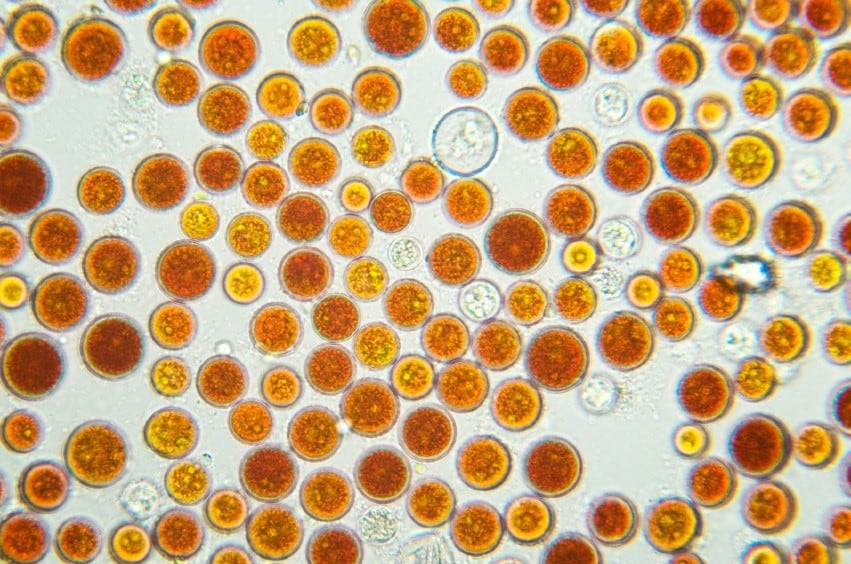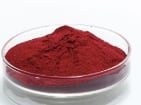Haematococcus pluvialis, the algal species from which astaxanthin is derived, requires sunlight and a stable temperature to grow in either open ponds or closed systems. In China, the best place to locate the production facilities seems to be in Yunnan Province, in the country’s extreme southwest, where both BGG and InnoBio have their growing facilities.
BGG has an 80-acre site using a closed tube system operating not far from Kunming, the province’s capital. The site has been developed over the past seven years, and in that time until quite recently all of BGG’s production, which began at pilot stage in 2007 and reached commercial scale in 2012, was going to a Japanese customer, said Joe Huff, vice president of sale for North America. Now that that facility has reached full scale production, the company has enough to be a major player on the North American and world markets, and help make shortages of the ingredient that have plagued its development from time to time a thing of the past.
“BGG has quickly become one of the leading producers of natural astaxanthin, and we have a clear plan in place to become the world’s largest grower within the next two years. We have practically unlimited space to expand and have an extensive construction team ready to crank up expansion timelines if necessary,” Huff told NutraIngredients-USA.
Huff said the company’s closed system is more expensive to implement over an open pond cultivation method but provides advantages both in purity and consistency of production.
“It it is a completely closed system so it isn’t subject to contamination and invasive species the way other systems are. This has been another huge problem among astaxanthin suppliers—not only didn’t they have the capacity to handle quickly escalating demand, but contamination would often lead to lost production lots that would further exacerbate the problem. In over seven years growing Natural Astaxanthin, BGG has never lost a lot to contamination or invasive species,” Huff said.
Those advantages also drove InnoBio to choose a closed system as well, said David Chance, InnoBio’s manager of sales and marketing. Chance said the company currently has two sites producing astaxanthin in Yunnan with another under construction in Tibet.

“InnoBio initially started with an open pond process but has rejected this process due to the potential for biological contamination. We currently use a modified proprietary bioreactor method for production and an exclusive process of extraction to ensure a high yield of astaxanthin,” Chance said.
Chance said InnoBio started as a contract laboratory, and a collaboration on a university research project on marine biotechnology led it in the direction of marine ingredient technology and resulted in the company’s first encapsulated astaxanthin product in 2008. That close link with academia in the country continues to bear fruit, he said.
“Some of the cost savings in our products come from a very close collaboration with a Chinese research university to develop methods of high density, efficient cultivation of biomass in our reactor system,” he said.
Durable demand
Both Chance and Huff said demand for astaxanthin doesn’t appear to be tailing off. The ingredient has solid research behind it, something that helped underpin and extend the boost in popularity the ingredient enjoyed after an a Dr Oz Show segment several years ago touting the ingredient’s benefits.
“InnoBio expects to see substantial long term growth in the astaxanthin market in both the US and Europe because of the growing number of positive results reported in the press regarding the safety and potential benefits of using astaxanthin,” Chance said.
“The main areas of research have been in eye & brain protection, joint health, skin improvement, cardiovascular benefits and improvement in athletic performance. And several other benefits with fewer yet clearly positive studies have emerged as well. The research has been going on for many years and is extremely diverse. Way back in the late 1940’s and 1950’s scientists in France showed that astaxanthin has fantastic potential for eye and brain health. More recently, it seems like everyone’s getting involved. Companies like Gatorade have jumped on the bandwagon—they did a study showing that competitive cyclists could significantly improve their race times by using only 4 mg per day of natural astaxanthin,” Huff said.
Huff said the scientific results are backed up with results at the consumer level. Word of mouth is proving to be some of the most effective marketing of the ingredient, he said.
“Once they start taking it and feel the benefits for themselves, they’ll be part of the ‘snowball effect’ and will be telling all their friends to take it too. Plus, the same thing is happening in the athletic community and for active people under 40. This is a supplement that pretty much any adult will feel specific gains from using,” he said.
Synthetic vs natural

Astaxanthin, like a number of other carotenoids, can be found in the market in both natural and synthetic versions. While the purveyors of synthetic ingredients tout the “nature identical” aspect of their ingredients, both InnoBio and BGG are quick to point out the difference.
“Astaxanthin exists in stereoisomers, geometric isomers, free and esterified forms. Haematococcus pluvialis biosynthesizes the (3S,3,S)-isomer, the most biologically active isomer, Synthetic astaxanthin is comprised of (3S,3,S), (3R,3,S) and (3R,3,R) isomers. The research shows that the benefits from natural astaxanthin, specifically anti-oxidant potential are greater,” InnoBio’s Chance said.
“There is not one clinical study ever published showing any health benefit for synthetic astaxanthin. We have no idea if it will do any good for people taking it. So while there are almost 100 positive human clinical trials proving that natural astaxanthin has a plethora of health benefits for people, there isn’t any evidence that Synthetic Astaxanthin can do anything for us. The only evidence out there comparing the two are a few different head-to-head antioxidant tests published in the peer-reviewed journal NutraFoods back in 2013. In research done at Creighton University as well as at Brunswick Labs, natural astaxanthin was a minimum 20 times stronger in antioxidant activity than synthetic astaxanthin,” Huff said.
